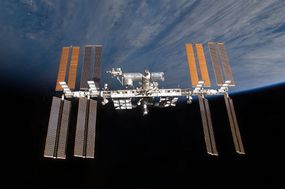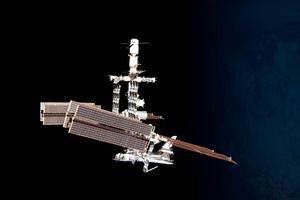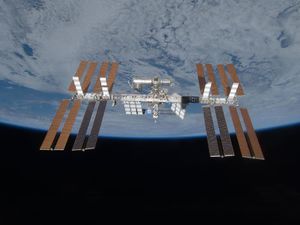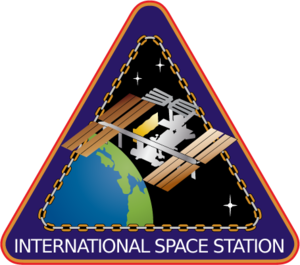International Space Station
| International Space Station | |
 The ISS as of STS-129 | |
| Spacecraft Characteristics | |
|---|---|
| Base Hull | Custom modules |
| Owner | UN Office for Outer Space Affairs |
| Flag of Record | United Nations |
| Launched | 1998 - 2010 |
| Purpose | Microgravity research |
| Primary Crew | varies |
| Operational Status | Active |
| “ | This is such a phenomenal place to be. I'm an adult busy working, but the little boy in me is screaming and running around and laughing. | ” |
| —Chris Hadfield, commanding the International Space Station, 13 February 2013 | ||
The International Space Station (ISS) is the last operational piece of unenhanced manned space hardware left in the solar system. Completed in 2010, it is administered by the United Nations Office for Outer Space Affairs (OOSA) on behalf of its member space agencies from Europe, Asia, and South America, and maintained by Project Artemis. The ISS has been continuously occupied by a succession of crews since November 2, 2000.
The ISS routinely orbits Earth at an altitude of 400 km. While the station is able to orbit at an altitude as low as 278 km, it no longer does so because of atmospheric drag concerns. The ISS can orbit at an altitude of 460 km, but the Soyuz capsules operated by the FKA for crew rotation have an operational ceiling of 425 km.
The station has a pressurized volume of approximately 1,000 cubic meters. Assembly began in November 1998 with the launch of the Zarya storage module, and finished in 2010 with the installation of the Cupola direct-observation module. The ISS has a rated crew of six.
History
The design of the ISS grew from a collection of proposed national space stations - the projects that would have built NASA's Space Station Freedom, the FKA's Mir-2, the ESA's Columbus, and JAXA's Kibou experiment module during the "space race" of the mid-twentieth century all contributed parts of their respective station plans to what was originally called Space Station Alpha. NASA brought the CSA into the project by requesting they build the station's main manipulators, Canadarm2 and Dextre. These five space agencies signed the Space Station Intergovernmental Agreement in January 1998.
Module Zarya was launched in November 1998. After the Unity and Zvezda mudules were added, the station's first crew boarded the ISS in November 2000. The station has been inhabited ever since.
The loss of the original Shuttle Columbia in February 2003 caused a two-and-a-half year grounding of the Shuttle fleet, interrupted by a single flight of Atlantis in mid-2005 to carry out an urgent logistics mission to the ISS. This slowed construction of the station considerably.
The relatively sudden appearance of handwavium in early 2008 lead to discussions amongst the member agencies of the Space Station Intergovernmental Agreement as to whether they would make use of the new technologies. It was eventually decided that the station's construction was too far along for changes at such a late date, the technology was still unproven, and "Hard Science has no room for handwaving." Because of this decision, the ISS does not incorporate any handwavium technology.
The installation of the Cupola in late 2010 completed construction of the ISS. This was marked with indifference; so many other stations were already functioning (including the TSAB station Benjamin Franklin) that the achievement was treated in most circles with less respect than it deserved.
The International Space Station was always seen as "one of NASA's projects" in the US space community. When TSAB eclipsed NASA in the early 2010s, support for American involvement in the ISS waned, purely for political reasons. Finally, TSAB used The Calling Port's near-miss of the ISS in January 2013 as a pretext to pull out of the Space Station Intergovernmental Agreement altogether, and the CSA quickly followed their lead, both agencies selling their portions of the station to the European Space Agency and JAXA. The ESA, the FKA, JAXA, and various other space agencies did their best to take up the slack, but apathy about continued hardtech space exploration in their home nations' governments and the expense of buying out the portions of the ISS previously owned by NASA and the CSA meant they were unable to properly maintain the station. Turning over full ownership of the ISS to the OOSA bought the station a few months of extra operational time as many of the world's other space agencies contributed to its upkeep, but the UN's pockets have never been very deep. In early 2014, they turned to the Fen, hoping to find a "white knight".
They found one in the Stellvia Corporation. When the Artemis Foundation took over NASA's space operations and facilities, they also took responsibility for maintaining the ISS. Artemis respects the unique nature of the station's technology and uses absolutely no handwavium in this maintenance.
In addition to the station's maintenance, Artemis also resurrected the NASA Commercial Orbital Transportation Services program. They purchased the plans and prototypes of the K-1 Vehicle (which had been mothballed before launch in October 2007) from Rocketplane Kistler, and subcontracted completion of the first functional ship to the VVS in June 2014. That first K-1 was completed with handwavium technology, and its computer system has developed an AI whose personality is based on the character Keiichi Morisato from Ah My Goddess; this is believed to be a result of R. Sora Hasegawa's involvement in the project interacting with the K-1's model designation. The K-1 series serves as the primary ISS resupply ships, making regular runs between Baikonur, the Guiana Space Centre, the Tanegashima Space Center, and the station.Structure
| “ | 18,000 miles an hour, fueled by science and solar power, The oceans racing past, A half a thousand tons, Ninety minutes moon to sun, A bullet can't go half this fast |
” |
| —Barenaked Ladies and Chris Hadfield, I.S.S. (Is Somebody Singing) | ||
The International Space Station is unique in being the only existing space station constructed purely with mundane materials and techniques.
There are fourteen pressurized modules in the ISS. In order of installation, they are:
- Zarya (storage module)
- Unity (berthing hub)
- Zvezda (station service module: main living quarters, environmental systems, attitude & orbit control, dock)
- Destiny (laboratory, environmental systems, living quarters)
- Quest (primary airlock)
- Pirs (dock, spacesuit storage space)
- Harmony (the "utility hub" of the ISS - electrical power, data bus, module berthing hub)
- Columbus (research facility)
- Kibou Experiment Logistics Module (experiment storage)
- Kibou Japanese Pressurized Module (laboratory)
- Multipurpose Laboratory Module (laboratory, docking and cargo logistics, crew lounge, attitude control system)
- Docking Cargo Module (dock, cargo storage)
- Node 3 (life support, module berthing hub)
- Cupola (observatory - aimed at Earth)

The ExPRESS Logistics Carrier, deployed to the ISS in late 2009, is an unpressurized module that supports experiments conducted in the vacuum of space.
| Tourism |
| While a very few tourists visited the International Space Station before the 'wave, they were always underfoot. The station is neither equipped nor intended for tourism, and even the most bare-bones Fen station is more luxurious than the ISS anyway. |
Activities
With the Fen presence in space handling many of the original purposes of the ISS, the OOSA has tightened the station's focus to concentrate solely on scientific research that requires microgravity or direct observation of Earth. The complete absence of handwavium on the station reassures many scientists of the reliability of the data obtained during the experiments carried out aboard the ISS.
The station's main fields of research include biomedical research, biotechnology, fluid physics, materials science, quantum physics, astronomy, cosmology, and meteorology. The long-term goals of this research are to develop new ways to treat diseases and more efficient methods of producing materials, to take more accurate scientific measurements than are possible on Earth, and to extend mankind's understanding of the Universe.
Originally, the ISS was also involved in developing the technology necessary for human-based space and planetary exploration and colonization. Fen research into handwavium technology has made this part of the station's remit moot.
| ||||||||

